
Andy Warhol
Wrapping Paper, 1956
Now that the holiday season is in full force, we at Minnie Muse want to delve deep into the historic, cultural, and metaphoric implications behind that shiny, colorful paper that hides our presents under the tree. The idea of the physical form “wrapped” — be it an object, body, architecture, or natural structure — juxtaposes the interior and exterior, revealing the complicated nature that ties the two together. Presented as separate entities, in reality the interior and exterior are intertwined: a discovery that becomes clear through cultural manifestations of the wrap.
In fashion in particular, the complex relationship between the human body and what covers it brings to light this melding of the interior and exterior. On its own, a garment is not much more than a piece of fabric, devoid of life and meaning. Wrapped around the body, however, the fabric is transformed: it takes on movement and cultural significance. Through fashion, one’s personal expression — or interior — melds with their public perception — or exterior — to create the true self.
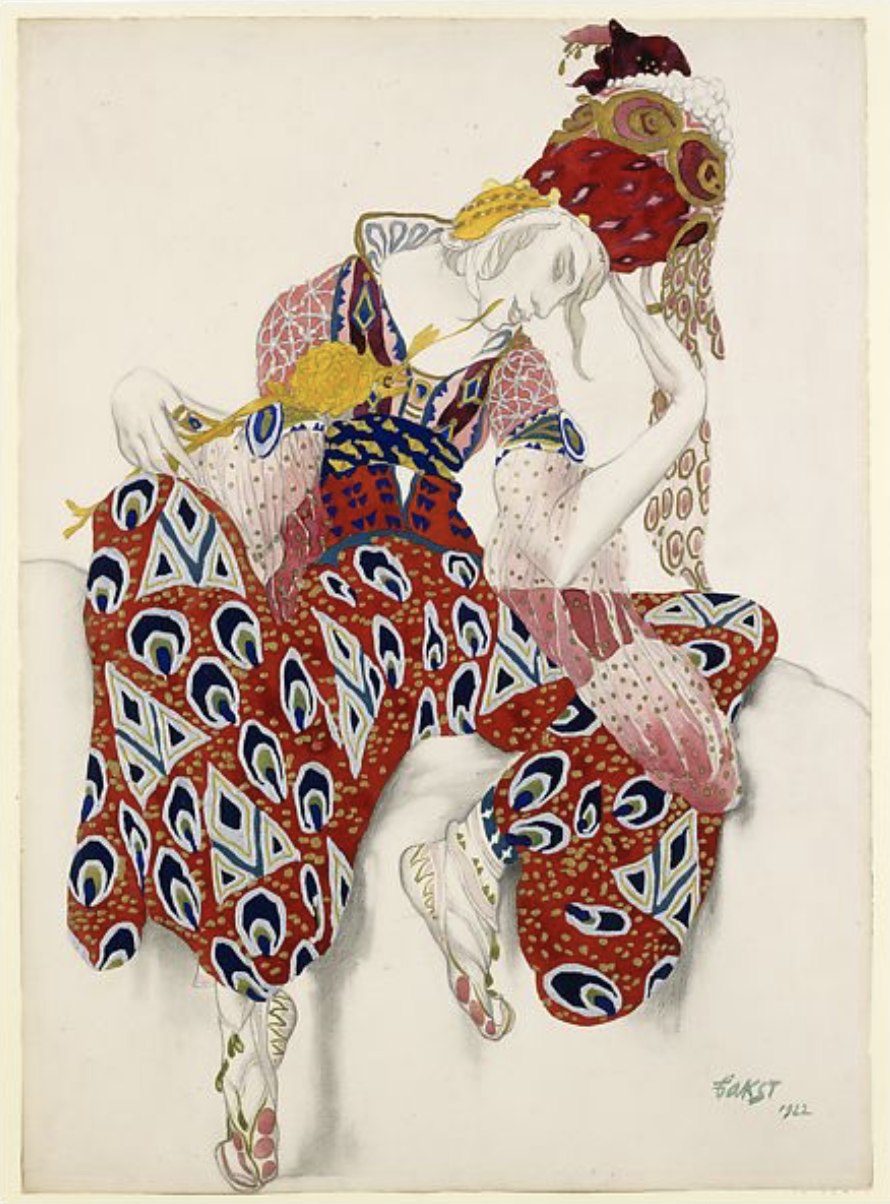
Léon Bakst
Costume Study for Wrapped Headdress and Jumpsuit, The Ballet "La Péri" (The Flower of Immortality), 1922
A variety of wrapped garments have existed within cultures and religions for centuries. One of the oldest examples of this is the turban: a headdress made of one long piece of fabric wrapped around the head. Although these garments play an important role in many religions, evidence of the turban dates back to 2350 B.C., meaning they predate modern religions and, therefore, probably did not originally derive from religious customs or ideas of morality but from necessity, probably to protect one’s head from the hot sun while working. In the 18th and 19th centuries, the “fashion turban” became popular, in part because of rising globalization and increased trade with India. In the 20th century, the turban made a comeback thanks to designer Paul Poiret, whose garments took inspiration from the Middle and Far East. With the invention of cars and motorcycles in the early 20th century, the turban again took on a functional role protecting one’s hair during high-speed travel. The turban later trickled into Hollywood, where it became a widely popular style worn by stars like Marlene Dietrich.
Turban from the Head of a Mummy
3rd-early 4th Century
Headdress from the Head of a Mummy
2nd-early 4th Century
Turban
British, 1820
Paul Poiret
Haute Lady Portrait with Exotic Turban of Pearls & Feathers, 1910s
Paul Poiret
Turban, American, 1910
Elsa Schiaparelli
Turban, Italian, 1958-62
Saks Fifth Avenue
Turban, American, 1960
Sally Victor
Turban, American, 1960
Richard Avedon
Portrait of Marlene Dietrich
Japan’s idea of the wrapped garment, the kimono, originated in the mid-17th century. Like the turban, it is designed to be made from one long roll of fabric, with flat, square sleeves and a broad sash to tie the garment together. In Japanese culture, the fabric itself is imbued with meaning. Utilizing a wide array of dying and embroidery techniques to adorn the garment, each kimono has a special meaning and use. Kimonos are chosen based on the formality of the occasion and the stature of one’s company. Like the turban, kimonos today have been appropriated into fashion, worn in the West as a decorative outer robe.
Another traditional wrapped garment, the sari, is worn in India, Pakistan, Sri Lanka, Bangladesh, and Nepal. Again, the sari is made from one uncut piece of cloth and wrapped securely around the body. Traditionally, the sari is made from handwoven fabric, and thus acts as a source of pride and patriotism for the country and its hardworking craftsmen, though today the tradition has been modified to include modern synthetic fabrics. Though there is a misconception that the sari should be secured with safety pins, it is woven with extra weight in certain parts of the garment in order to wrap and drape correctly without any outside help. The sari, especially, is a sentimental garment: certain saris are connected to certain special events such as marriage. In this way, a lifeless roll of cloth becomes embedded with spiritual meaning. In the meeting of the body and the garment, both become connected and transformed.
Unlined Summer Kimono (Hito-e) with Carp, Water Lilies, and Morning Glories
Japan, 1876
Kimono
Japanese, 19th Century
Kimono
Japanese, 19th Century
Kimono
Japanese, 20th Century
Kimono with Stylized Flowing Water
Japan, 20th Century
Sari
Bangladesh, 1880
Sari
Indian, 19th Century
Sari
Indian, 20th Century
Sari
Indian, 20th Century
Sari
Indian, 20th Century
In modern fashion, the tradition of a wrapped garment has maintained its popularity, perhaps for its simplicity, flattering nature, and minimal fabric waste. The earliest example of this in modern fashion is the Taxi Dress, created by Charles James in 1932. Conceived with the idea that the modern woman should be able to change in a taxi if she needs to, the garment uses sophisticated construction techniques so that the seamless top spirals into a wrap-over skirt. Similar to the sari and kimono, the wool dress was meant for universal fit and sold in only two sizes. Later, the design was modified to utilize the zipper for increased functionality.
A decade later, Claire McCardell created the Popover Dress. Created for the modern housewife during wartime, the dress was designed to be functional for cooking and chic enough for dinner. Using the common “house” dress as inspiration, the garment included a large functional pocket and denim wrap-front. It even came with an oven mitt. The functionality of the dress allowed it to be classified as a utility garment, thus making it inexpensive to buy during the war. The innovative design, which combined form with function, became the basis for a variety of future wrap-around garments.
Charles James
Taxi-Dress, 1932
Charles James
Taxi-Dress, 1932
Charles James
Taxi-Dress, 1932
Charles James
Taxi-Dress, 1932
Claire McCardell
Pop Over Dress, 1942
Claire McCardell
Pop Over Dress, 1942
Claire McCardell
Pop Over Dress, 1942
Claire McCardell
Evening Wrap Dress, 1950
Perhaps the most famous and long-lasting wrapped garment is Diane von Furstenberg’s iconic Wrap Dress. The universally flattering design borrows from its predecessors: one side is wrapped around the other, and the dress is secured by knotting the attached ties at the waist, creating a V-shaped neckline. Created in the early 1970s, von Furstenberg’s design stood out because of its jersey material which hugs the wearer elegantly while remaining comfortable and affordable. Another benefit of the wrap design was that it was easy to sew; Vogue even printed dress patterns so that readers could make their own. Like the sari, turban, or kimono, the wrap dress, while constructed to particular specifications, can be easily customized through hem length, collar, sleeves, and patterns.
Diane von Furstenberg
Newsweek, March 1978
Diane von Furstenberg
At Work, 1970s
Diane von Furstenberg
Vogue Patterns, Wrap Dress
Diane von Furstenberg
Vogue Patterns, Wrap Dress
In the art world, the nature of the wrapped object is often explored. The relationship between the interior and exterior, as well as the wrap’s ability to enshroud, shrink, or hide the object, is the subject of much speculation within art. Italian sculptor Antonio Corradini’s 18th century work “Bust of a Veiled Woman” applies Classical sculpture’s enthusiasm for the appearance of soft, fine drapery in marble. The significance of the veiled figure in this context can signify a holy figure or, ironically, a promiscuous one. In Rene Magritte’s “The Lovers I”, the artist repeats a motif used throughout his work. The figures’ faces are covered with white cloth, obscuring their identity and emotion. What could be an average portrait, with the wrapping, gains an air of mystery — are the lovers solemn, angry, joyous? With the wrap, their expression can be contemplated by the individual viewer. Sandy Skoglund’s “Body Limits,” photographed in 1992, pushes this idea further. The surreal image is composed of models carefully staged in a set, all covered in raw bacon. Skoglund’s method of wrapping and obscuring calls attention to the “wrap” itself — the artist using food motifs throughout her work. The staging of the image in extremely impressive; it almost looks photoshopped, though it is not.
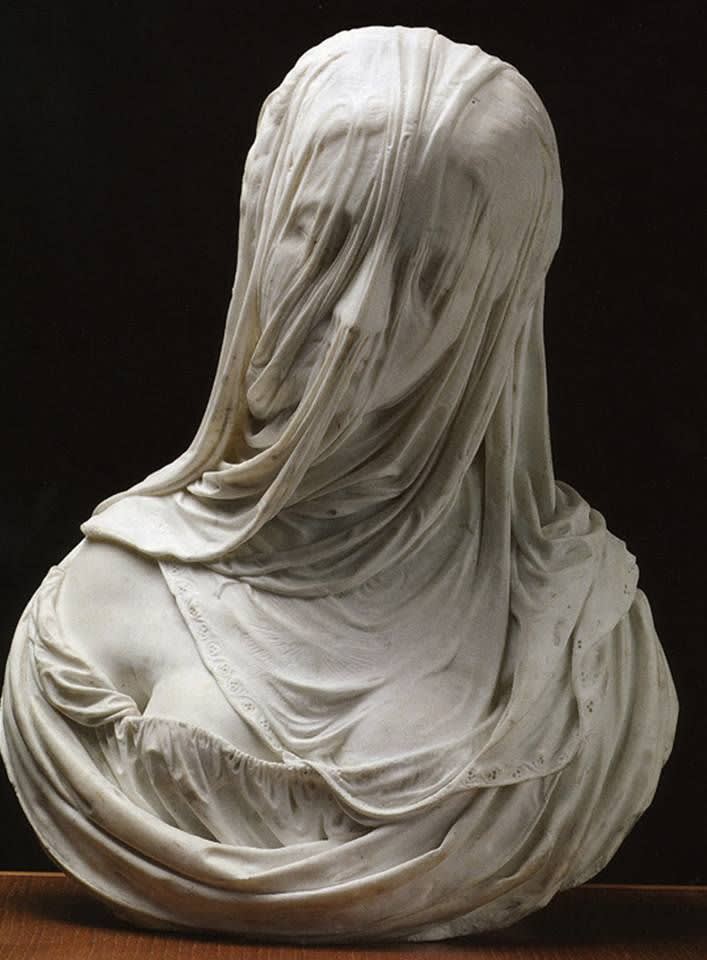
Antonio Corradini
Bust of a Veiled Woman, 1717-25
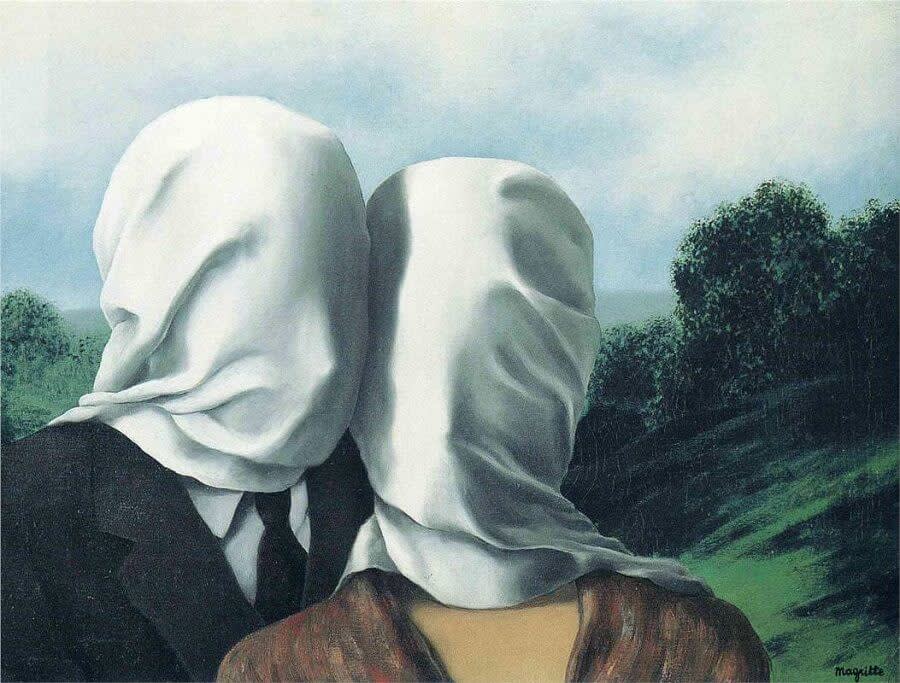
The Lovers I
Rene Magritte, 1928

Sandy Skoglund
Body Limits, 1992
William Wegman, an artist made iconic by his whimsical, surreal photographs of his beloved pet Weimaraners, has several ingenious examples of the veiled or “wrapped” figure. His 1976 work, “Man Ray Under Sheet” and 1989’s “Spirit of Chiffon” create wonderfully humorous images. Unlike Magritte’s representation of the veil, Wegman’s translucent coverings bring attention to the nose and ears of the dog, making him appear as a ghostly and surreal version of himself. The decision to use a covering that does not completely obscure the four-legged subject allows the dog’s clever expressions familiar to viewers of Wegman’s work to juxtapose with the cloth covering him. In Wegman’s 1990’s piece, “Of the Cloth,” a simple piece of cloth is anthropomorphized when draped atop the artist’s subject.
Multidisciplinary artist Daniel Arsham’s works combines art with architecture, playing with impossible images and structures. In his 2012 works “Hollow Figure,” and “Wrapped Figure,” Arsham morph the gallery walls themselves, sculpting figures wrapped within flexible cloth-like structures, appearing to be pressed into the walls by a strong gust of window. Jeff Koons’ “Baroque Egg with Bow”, a stainless steel sculpture, places its emphasis on the painstakingly detailed wrinkles in the foil.
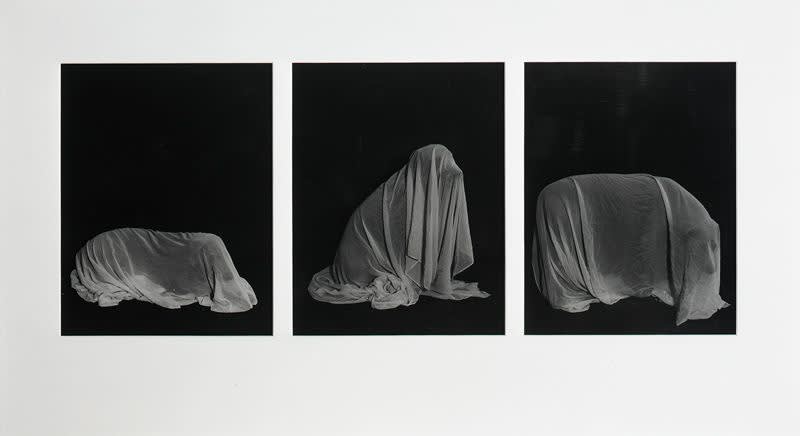
William Wegman
Man Ray Under Sheet, 1976
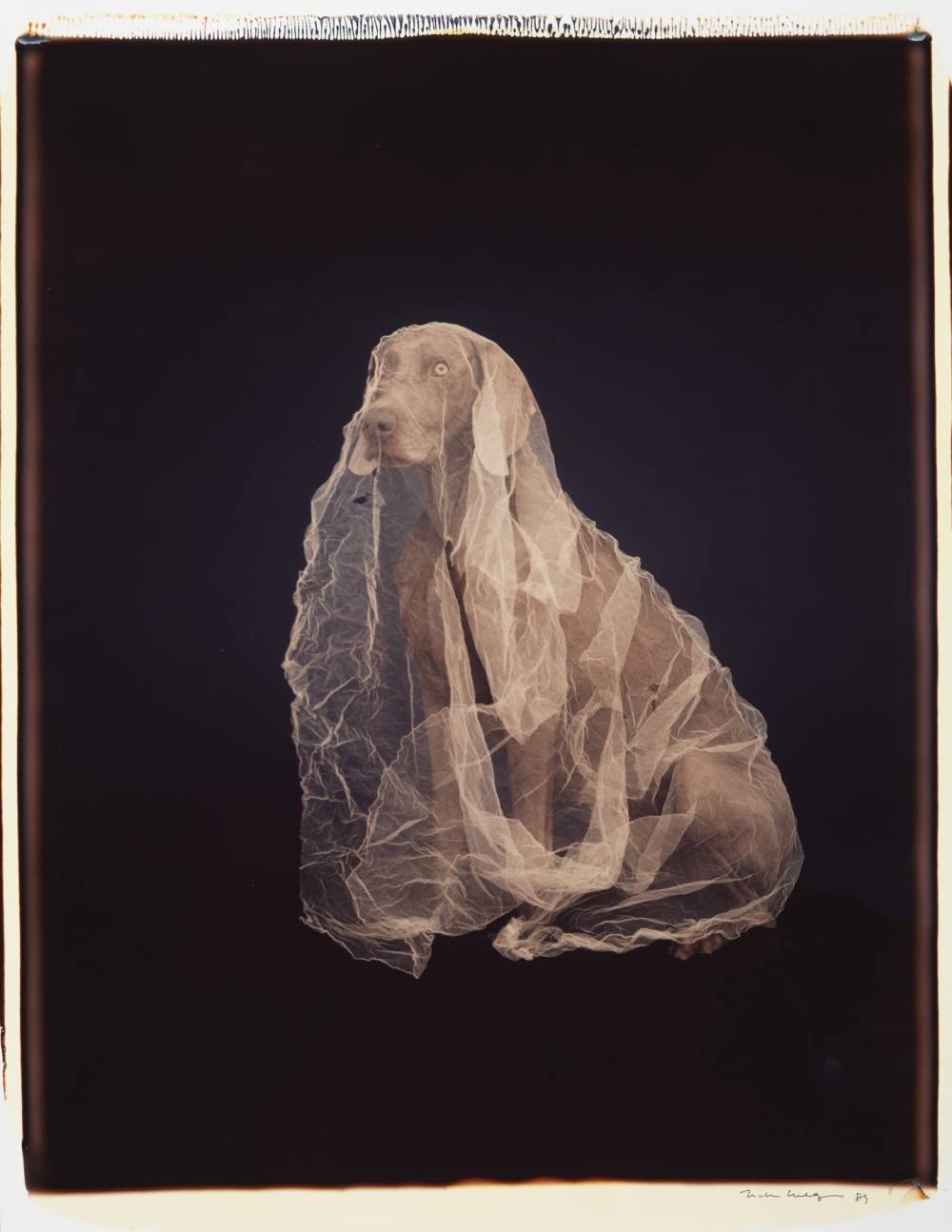
William Wegman
Spirit of Chiffon, 1989
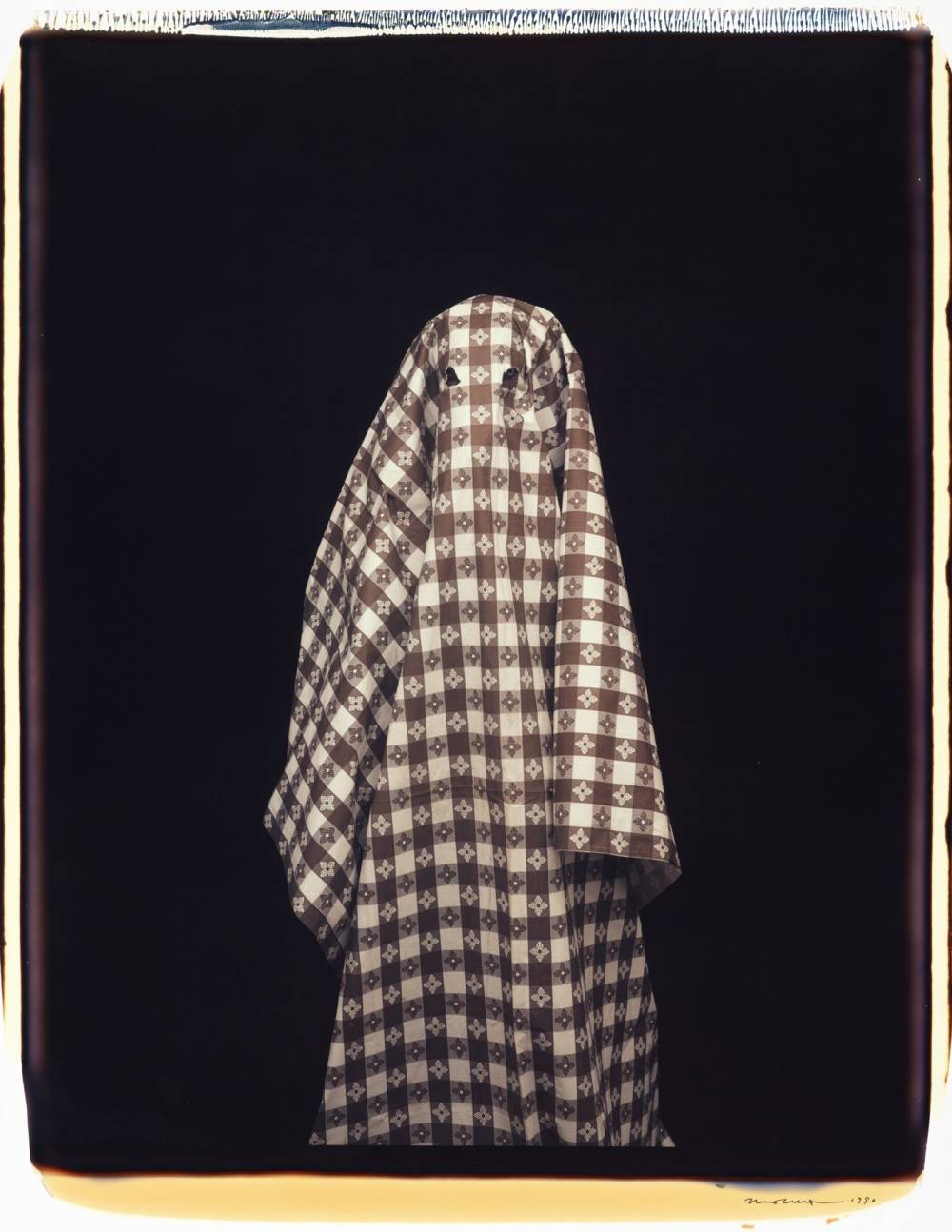
William Wegman
Of the Cloth, 1990
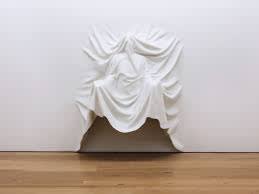
Daniel Arsham
Formless Figure, 2012
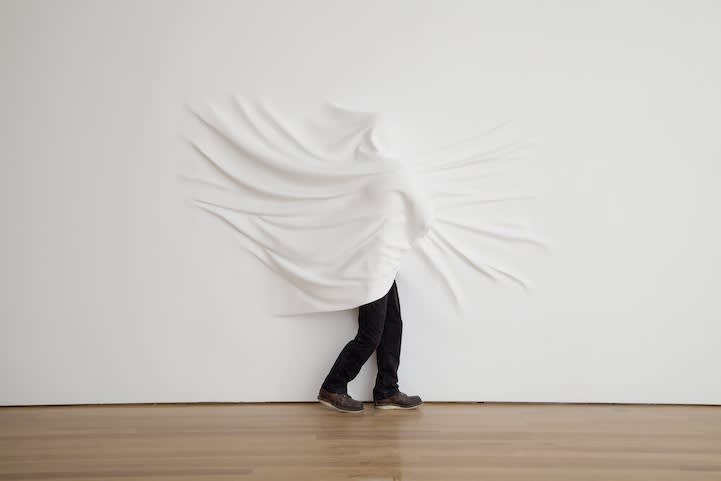
Daniel Arsham
Wrapped Figure, 2012
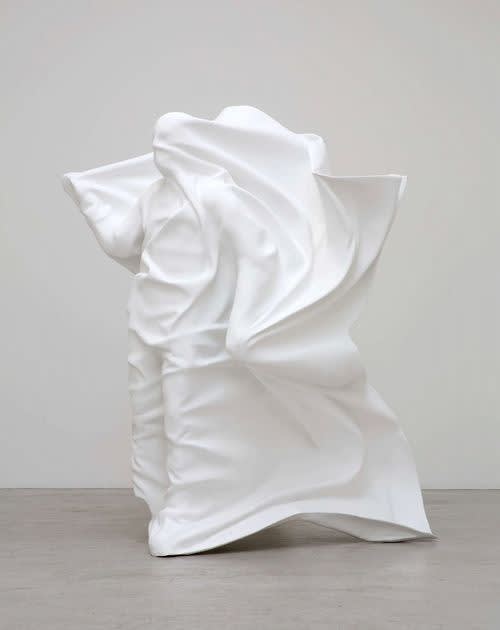
Daniel Arsham
Hollow Figure, 2012
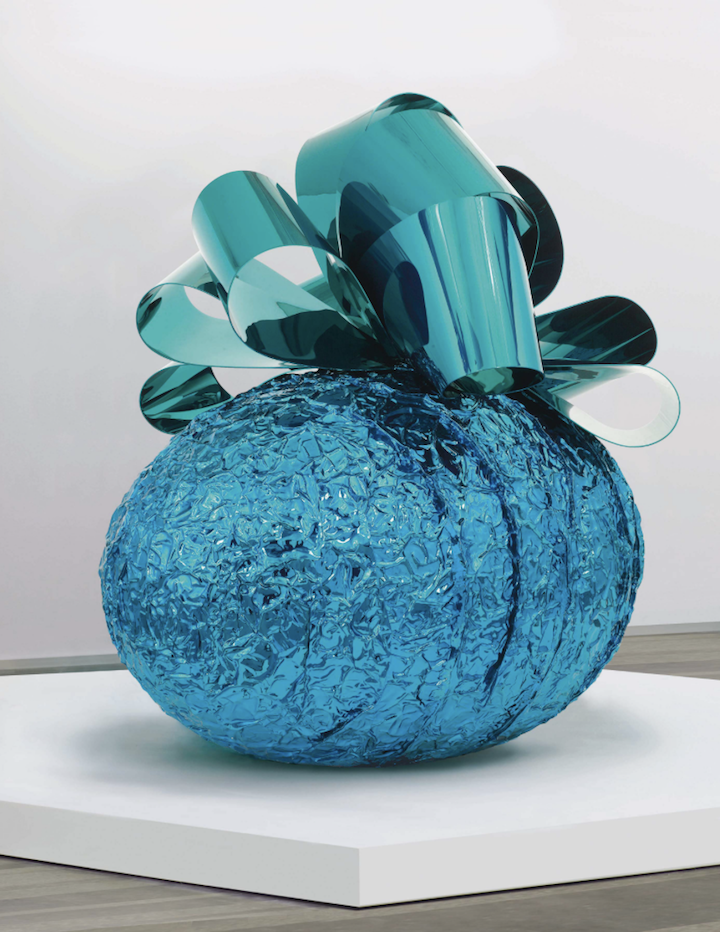
Jeff Koons
Baroque Egg with Bow (Blue/Turquoise), 1994-2008
Artists Christo and Jeanne-Claude explored wrapping on a monumental scale, using buildings and nature as their subjects. Christo’s early work started small: wrapping objects and furniture. His 1962 work “Wrapped Motorcycle” is one such example. After meeting in 1958, Jeanne-Claude and Christo’s projects grew massively in scale. Their 1968-69 work, “Wrapped Coast,” saw the duo covering coastal cliffs in Sydney, Australia. The project utilized one million square miles of fabric and 35 miles of rope to cover the area. Their use of the landscape defies expectations of art as something able to fit in a picture frame or on a gallery pedestal. In 1971, the pair proposed a new project: “Wrapped Reichstag.” Utilizing the parliament building in Berlin, Jeanne-Claude and Christo had to wait out the Cold War, not completing the project until 1995. The combination of sculpture, architecture, and installation in the work — which remained wrapped in over 1 million square feet of fabric for two weeks — is unlike anything the art world had seen before.
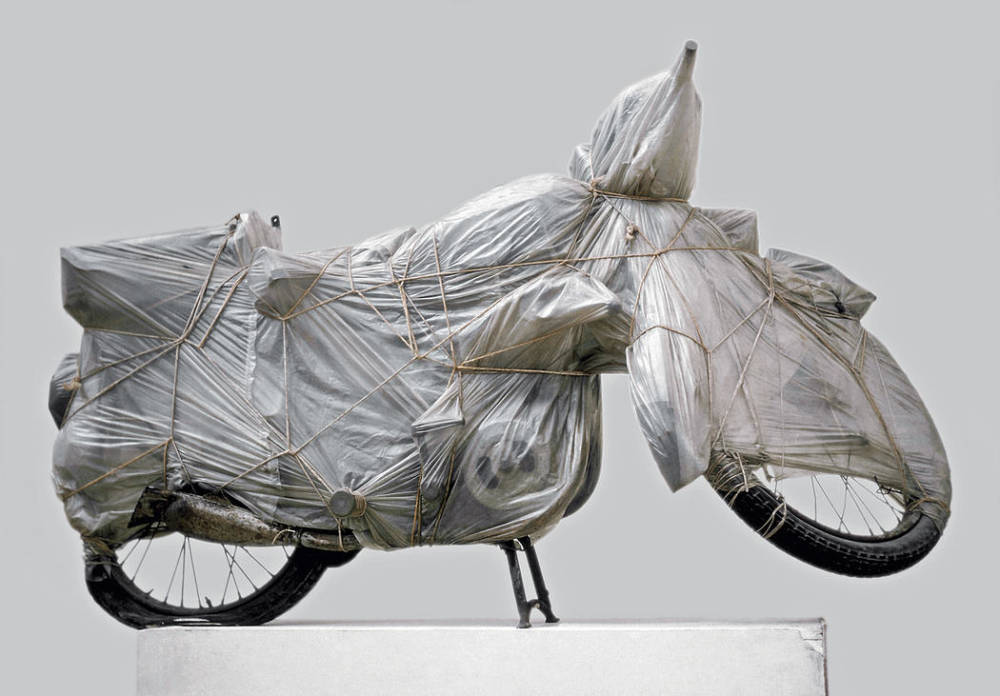
Jeanne-Claude and Christo
Wrapped Motorcycle, 1962
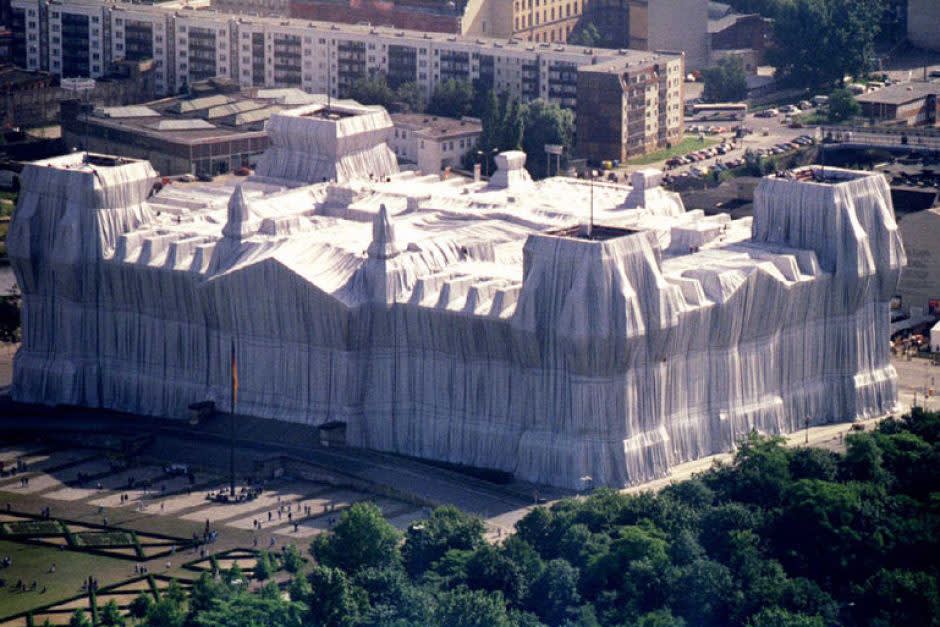
Jeanne-Claude and Christo
Wrapped Reichstag, 1995
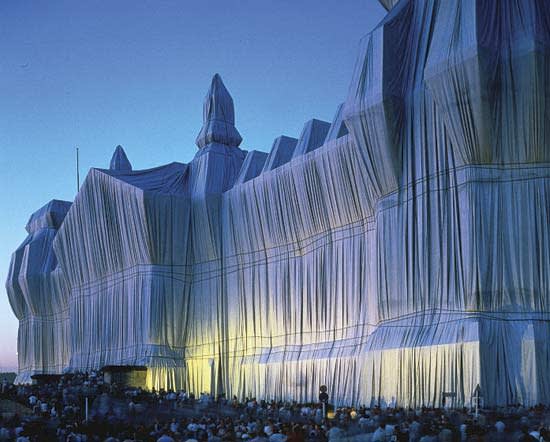
Jeanne-Claude and Christo
Wrapped Reichstag, 1995
A reverse version of Jeanne-Claude and Christo’s projects, the Barcelona artist collective Penique Productions creates wrapped interiors, with large sheets of fabric creating cavernous structures. In order to create these works, the artists inflate a custom oversized balloon to tightly fit the existing interior. The result is a fascinating, monochromatic composition. More reminiscent of Christo’s early work, conceptual artist Iain Baxter used the wrapping motif to memorialize Rebecca Levy, who occupied the apartment from 1918 until 2009. Preserving Levy’s apartment and its contents in translucent plastic, thanks to Baxter the eclectic collection ranging decades remains unmoved.
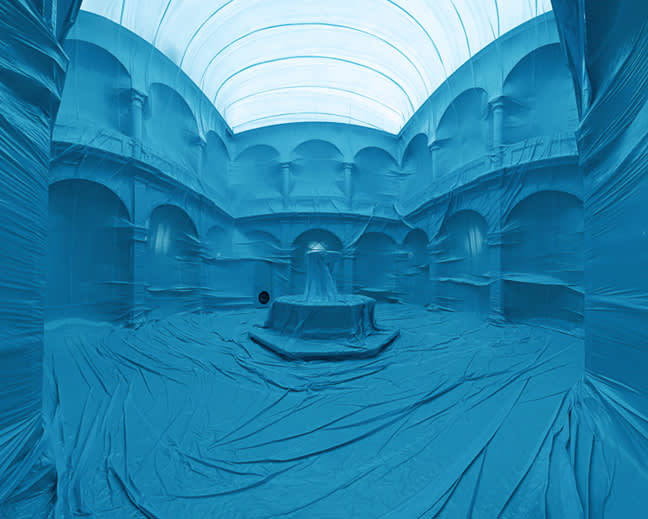
Penique Productions
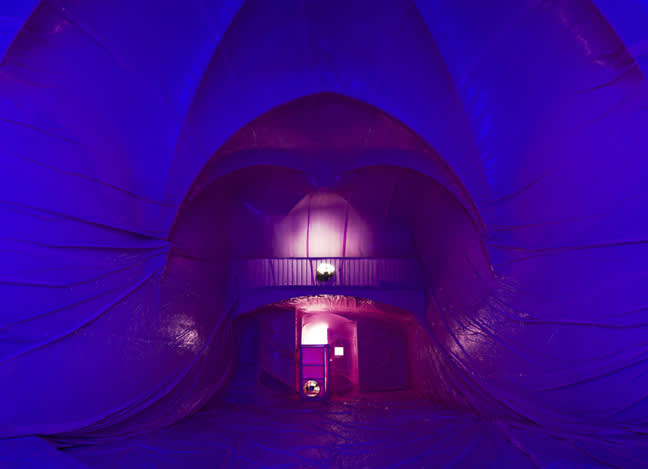
Penique Productions
La Capella, 2009
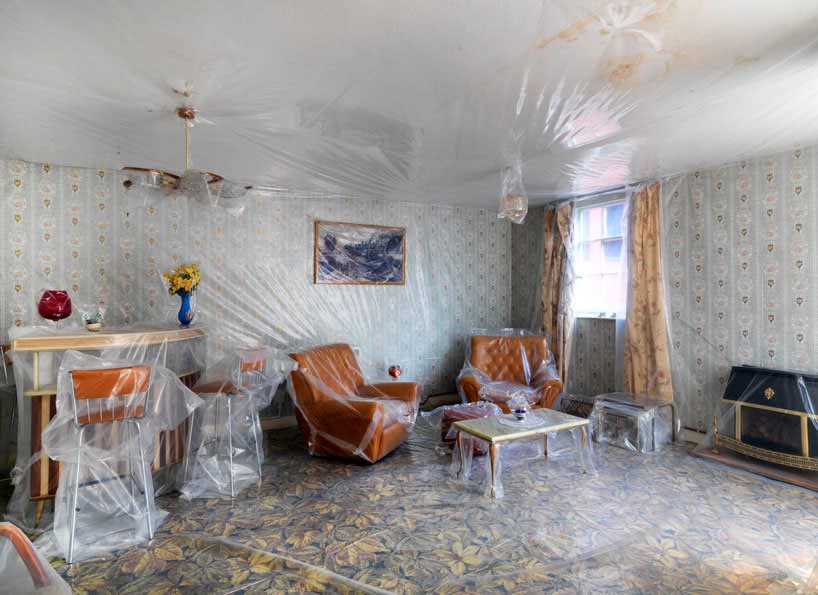
Iain Baxter
Rebecca's Bagged Place, 2013
The wrapping that we think of most this time of year — gift wrapping — has a surprisingly long history; the first case of decorative paper was documented in ancient China. In Japan, the act of folding paper over a gift is almost ritual. The paper is never cut, as ancient Japanese tradition prohibits cutting paper. Instead, like origami, the paper is folded and tied to disguise the gift. Another Japanese tradition, Furoshiki, swaps paper for large pieces of fabric to wrap gifts.
Like Magritte’s “The Lovers,” gift wrapping obscures the reality of the object from view, leaving the mystery of what the wrapping conceals for the receiver of the gift to guess. It is this mystery that makes opening gifts so special; it creates the anticipation that makes gathering around the tree so exciting. The gift and wrapping — interior and exterior — work together to elevate the object to an almost ethereal level.


